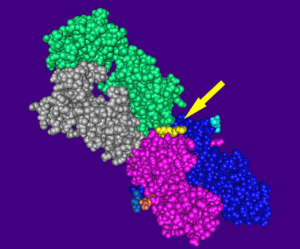
Complex of the human alpha/beta T cell receptor (green & grey) HA1.7, influenza hemagglutinin peptide (yellow), and major histocompatibility complex class II molecule, HLA-DR4 (blue & magenta). Created from MMDB entry 18804 using visualization package Cn3D4.1. Wikimedia Commons
CD8+ T cells have been shown to induce cross-protective long lived immunity against different influenza strains. However, induction of vaccine mediated influenza immunity, focuses on ability to induce robust antibody responses. However, due to antigenic drift of influenza virus, vaccine induced Ab immunity is not cross-strain protective, thus seasonal influenza vaccine require reformulation every flu season. The importance of influenza-specific CD8+ T cell immunity, has been shown by its association with milder seasonal disease and increased recovery in patients suffering from virulent epidemic causing influenza.
Studies in mice have shown that not all influenza-specific CD8+ T cells are equally protective. Specifically, presence of Influenza-specific tissue resident memory cells in the lung is indispensable for protective immunity against influenza. Pizolla et al., performed functional, proliferative and clonal phenotypic analysis of memory T cells in the lung, to determine the impact of TCR diversity on function.
Pizolla et al., used CD69 and CD103 to differentiate lung resident (CD69+CD103+) for other lung memory CD8+ T cells (CD69+CD1030, CD69-CD103-). Researchers observed reduced functional responses (TNF-α, Granzyme B, IFN-γ) with the exception of Perforin in CD69+CD103+ lung resident memory CD8+ T cells, compared to other lung memory CD8+ T cells. However, despite reduced functional activity, these CD69+CD103+ lung resident memory CD8+ T cells had similar proliferative ability as other lung memory T cells.
Researchers also showed despite having the least functional activity in response to non-specific stimulation, Influenza-specific CD8+ T cells had superior cytokine activity compared to CD69-CD103- and CD69+CD103- influenza-specific lung memory CD8+ T cells. In fact, majority of influenza-specific CD8+ T cells detected in the lung samples were lung resident memory cells. Finally using tetramers they were able to show that clonotype enrichment does not occur in lung resident memory cells specific for epitopes of the nuclear protein and M1 protein influenza proteins. In fact, there is high clonotype sharing between lung resident (CD69+CD103+) and other lung memory CD8+ T cells, illustrating a common T cell precursors between T cells with a different tissue homing phenotype.
Journal Article: Pizzolla et al., 2018. Influenza-specific lung-resident memory T cells are proliferative and polyfunctional and maintain diverse TCR profiles. Journal of Clinical Investigation.
Journal Article by Cheleka AM Mpande











